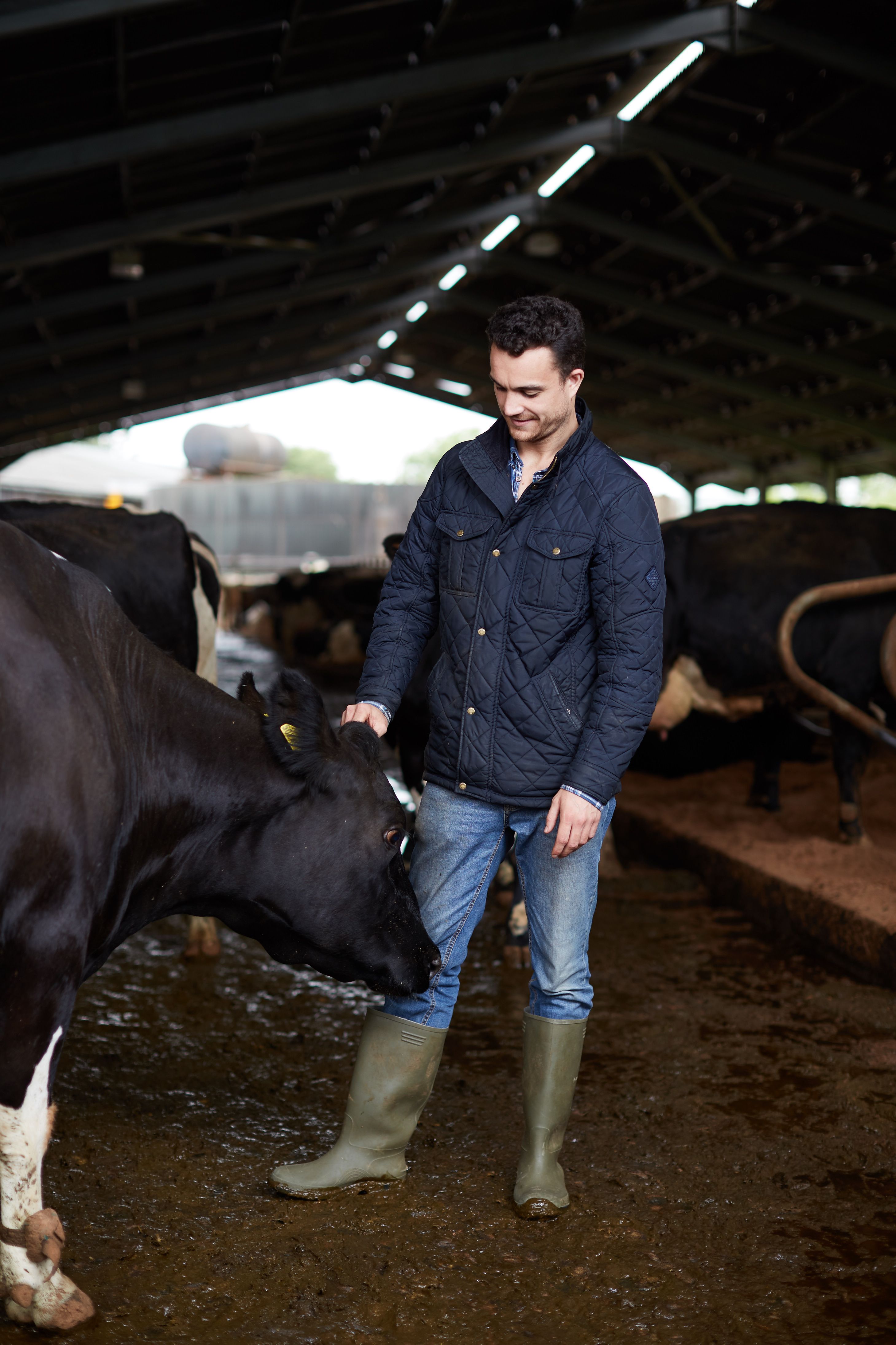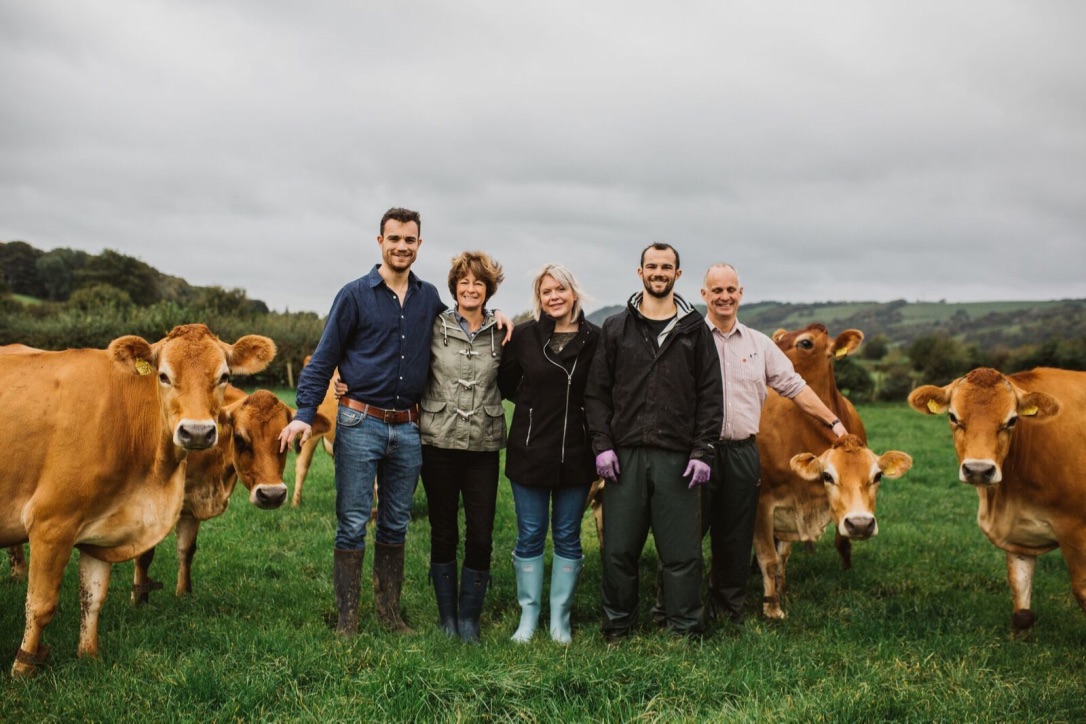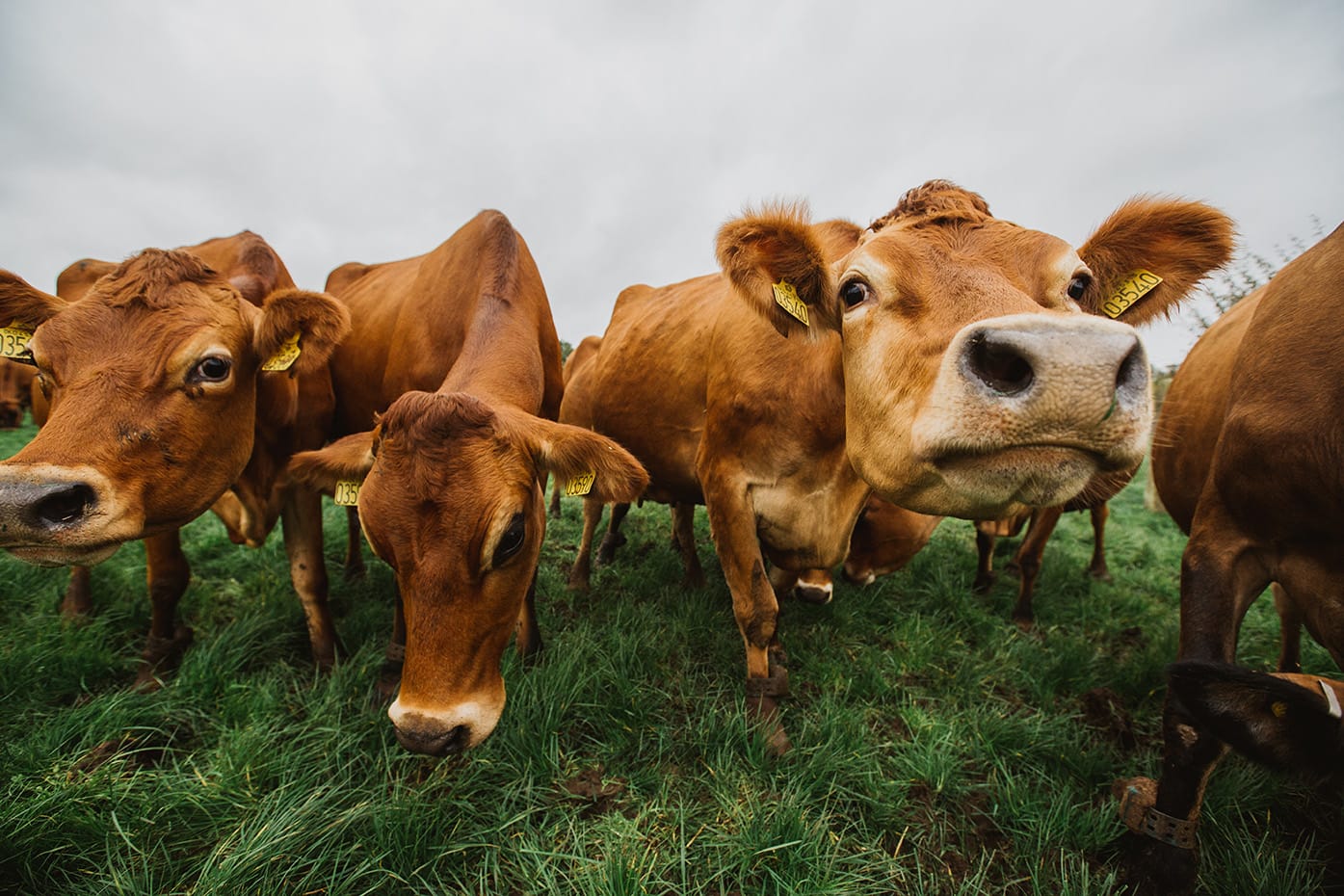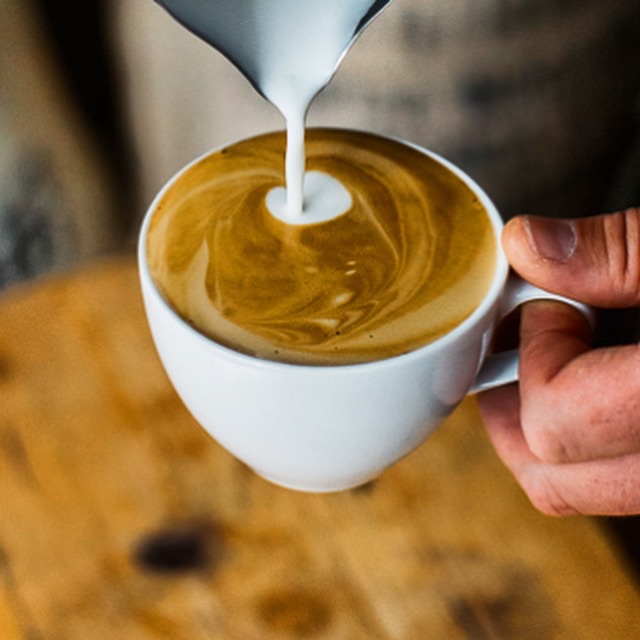
Meet Your Guest: Joe Towers
Meet Your Guest: Joe Towers, Brades Farm
Standart: Would you tell us a little about Brades Farm?
Joe: We’re nestled here in a little hamlet called Farleton, near Lancaster on the edge of the Lake District and the Yorkshire Dales. We’re milking about 380 cows. Our herd is made up of both Holstein Friesian cows—the typical black-and-white breed recognizable to most people in Britain—and Jersey cows, which are a lovely golden colour. We introduced the latter in late 2015 in order to develop milk that best suits the needs of specialty coffee. We’re particularly interested in the way that Jersey milk improves the butterfat and protein, and maximizes the quality of the milk, with respect to latte art and flavour.
We’re somewhat unique as dairy farmers in that we’ve always been responsible for marketing our own milk. Most dairy farms in Britain supply large companies who send milk tankers to the farms to collect the milk every other day, and that’s all the farmer sees of the milk after it leaves the cow. It’s then up to the larger companies to pool that milk, process it, and market it. Throughout most of his career, my father [also a farmer] would have processed the milk on the farm himself, and then sold it to either doorstop customers or small local businesses and corner shops. By 2015, however, the dairy industry was facing a global oversupply crisis, largely due to the end of milk quotas in the EU, which had previously always kept a lid on the production of milk. This was the catalyst for us to look to differentiate our product beyond just being a local milk, and that’s what led us to become Barista Milk.
Standart: How was it, to move from a smaller to a larger operation?
Joe: The biggest challenge was how to put the whole supply chain together. You have to build up a critical mass in terms of the demand in order to get a product like this going, so we started marketing in London. For an operation like this to be cost-effective, you need a large concentration of customers in a confined area.
Our product became popular much more rapidly than we expected; within a few months, we were selling more milk to the barista market in London than we were locally. A couple of years later, we sold our local rounds and focused on producing milk specifically for the coffee market. It’s been enormously rewarding; both our company and the product have been received with far more enthusiasm by baristas than we could ever have hoped. We’re been treated with admiration and gratitude, and people are excited to meet up and chat to us about how we produce the milk.
I’d worked in Kenya and Tanzania for a green coffee exporter during my placement year at university. It really gave me a sense of the passion in the coffee industry and even though I ended up joining the family milk business, I always wondered whether there was a way to tie these passions together.

Standart: One of the richer subjects to explore in the coffee world is how to increase connections across the supply chain. Do you feel a sense of connection with your end customers, given that your farm is located far from London?
Joe: Very much so. Less so in 2020, of course. We used to have visitors to the farm almost every week. People in the hospitality sector from all over the world would come to see what we do on the farm!
Before the pandemic, we’d also frequently go to London to spend time in coffee shops or to visit exhibitions such as the London Coffee Festival. It was very rewarding to see our milk being used in situ in these fantastic coffee shops in London, the passion the baristas have for what they do, and their curiosity about how we produce the milk.
Standart: A few years ago, baristas faced a real problem with the inconsistency of milk—how it would steam and react with the coffee. What would you say is the ideal milk for coffee?
Joe: That problem created our opportunity! About a decade ago, the art of specialty coffee was being developed across the board, but I think it’s fair to say that milk was somewhat neglected, despite it being such a large part of the coffee. We’ve been extremely lucky that there is a genuine market need for coffee that works well for baristas.
To answer your question more directly, as with the Jersey cows, it’s not very complicated. The right milk means going back to basics. You need a higher butterfat percentage, the protein content needs to be higher, and the milk should not be homogenized.
It was the rise of supermarkets that encouraged more standardization of milk, and one aspect of that is homogenization. All homogenization does is compress milk through very small holes and agitate it in order to break down the size of the fat globules. The fat is broken down into smaller particles that suspend equally throughout the milk, rather than rising to the top. This has been good for supermarkets and large retailers because it improves the shelf life and the visual aesthetic, but non-homogenized milk maintains the structure of the coffee better and higher butterfat and protein content, which makes it better for foaming and pouring latte art because the bubbles do not come up to disrupt the pattern.
When you foam milk, you stretch the protein molecules and increase the volume, and as a result the protein tries to bind to the air, which is what is happening when you see the bubbles that come up to disturb the latte art. However, when milk has a higher proportion of butterfat globules, the protein binds to the fat, which prevents damage to the structure of the steamed milk. And there’s another benefit: Because specialty coffee can be quite acidic, higher levels of butterfat can improve the flavour and overall balance of the cup, but you don’t want it to be too high, or the sweetness will simply drown out the flavours of the coffee.
Standart: How is the butterfat and protein content in milk measured, and what’s the optimal range for coffee?
Joe: It’s the same whether you read the figure as a percentage or as grams per 100ml, because a litre of milk weighs as much as its volume, i.e. one kilogram is equivalent to one litre. We believe that the optimal butterfat emerges at 4.5 per cent. However, dairies have worked out that they can improve their margins by skimming off the cream, which is worth much more than the milk. The bottom line is that farms are paid per litre, so they’ve always been incentivized to select cows, diets, and breeds that yield the most litres. That’s why you mostly see black-and-white cows—they produce the most milk. But as with most things in life, there’s a trade-off: As the litres go up, the amount of solids in the milk goes down—you produce more white water, essentially.
If people are buying milk to put on cornflakes or in tea, they don’t worry too much that the protein and fat content has gone down over the years, so this has gone all but unnoticed—except in the specialty coffee sector. That’s how we’ve been able to carve out a niche—by essentially going back a step and selecting a more traditional breed, one used more often to make cheese and yoghurt.
Standart: Do you see this as part of the general low-intervention trend we’ve seen in food systems more generally, such as light-roasted coffee and low-intervention wines?
Joe: It’s human nature to optimize things; if people interact with a system for long enough, it will eventually be optimized, which is what we’ve seen with milk. However, this optimization can increase risk, as well as lower quality. There’s an interesting parallel here with the pandemic; we’ve optimized lots of things on a global basis, and risk has sneaked up on us.

Standart: What does milk’s journey look like, from cow to cup?
Joe: Historically, most farms would have a collection every day. My great-grandparents took the milk in a churn to a railway station and it would go unrefrigerated down to Liverpool, but in the modern era, larger farms typically have enough storage to enable a milk tanker to collect their produce every other day. With enough storage, most farms can milk their cows twice per day. Our product is a bit different because it is fully traceable to our farm, but ordinarily, tankers will collect the milk from a number of farms, and then deposit the milk in a larger reload tanker, which takes it to the central processing site. The milk processing itself is pretty straightforward. It usually takes place in a factory with lots of stainless steel. When the milk arrives, it is tested for temperature, pasteurized, (usually) homogenized, and skimmed, after which it is placed in plastic cartons and shipped out to the shops. Milk is sold fresh, so if it’s not going into a product that has a long shelf-life, the whole process has to be very quick.
Standart: Can you recreate for us a day in the life of your farm, and what a visitor might see?
Joe: The cows are milked twice per day, between 6:00 and 8:30 a.m. and then again at 6:00–8:30 p.m. The cows are fed in the morning, after which we have various tasks to carry out. These can be typical maintenance work, seasonal tasks, and spreading manure back onto the field to cycle the minerals that the cows eat—putting it back into the ground to supplement the soil is a fundamental part of the process, but it’s also subject to the weather. It’s too wet in January and February! Farmers are driven by the weather. In the summer, we make the silage; and when we get a spell of dry weather, we cut the grass and ensile it, which causes it to ferment, and makes it available for the cows to eat in winter, when they’re housed. Last summer, we had very few visitors so we took the time to build an overhead walkway in the shed so that future visitors will be able to walk above, rather than through, the cow muck on the ground. A lot of the jobs are done at the same time as the cows are milked, when we have enough people to spread tasks out. Some people will be in the milking parlour plying the clusters—the equipment that pumps the milk from the udders—while others might be doing the calf feeding, which is a very important task.
A typical visit involves picking people up from the station, giving them some food and a coffee, and then going for a walk among the cows and a chat about what we do.
Standart: You said that optimization leads to increased risk. How has the pandemic affected your business?
Joe: We’ve been constantly surprised by the resilience of our market. Given that we have developed a milk that is optimized for coffee, we have a lot of our eggs in one basket, but although you might assume that we’ve had a bad year, sales-wise, we’ve been pleasantly surprised. That obviously speaks to the recourse to take-away that coffee shops have, as well as to the underlying growth of the specialty coffee market, which has persisted despite the pandemic. We’ve been very fortunate that our market has been resilient.
Standart: How has Brexit affected your work and planning for the future? We hear plenty from politicians, but rarely straight from the source.
Joe: We knew it was going to happen since 2016, but like most businesses, we really had no idea what was going to happen in respect to the trade deal and what it would actually look like. There has been a lot of uncertainty, but now that it’s become clear that the trade deal is more or less a free-trade agreement with the EU, we haven’t seen any major disruption in terms of prices or milk being over- or under-supplied, which was the speculation in case of a no-deal Brexit.
Food companies have been trying to create resilience to the possibility that they’d be cut off from many products that come into the UK. Since 2016, we’ve seen more appetite for British provenance from retailers and companies who wanted to reduce the risk of disruption if the UK didn’t get a trade deal and the pound weakened.
Brexit has created an opportunity for policy to be rethought in the UK and redeveloped with respect to agriculture and land use. Hopefully, this will lead to positive change for the industry.

Standart: There seems to be a widespread coupling of ethical consumption and veganism, and dairy has even developed something of a stigma in specialty coffee. Do you think that this trend will affect the industry more widely in the future?
J: Even speaking more broadly about society, by and large this has been the case. So far, the data suggest that milk sales are declining by 1–2 per cent per year, but that the decline is more driven by the change in consumer consumption patterns in what they call ‘host foods’—cups of tea, and that sort of thing. The vast majority of the reduction of fresh milk consumption is unconscious, and not based on ethical or conscious concerns.
Obviously, the environmental side of things is of paramount importance; that’s a trend that’s here to stay. Whether more people start to consciously choose to leave dairy is very much subject to the extent to which we as an industry can improve, as well as communicate with the public.
I think that the conversation is becoming a lot more nuanced. It’s a complex issue that used to be painted by certain interest groups as a simple narrative—that the way to save the planet was to abolish livestock products. However, it’s not that simple, and now we are thankfully seeing a more sophisticated debate taking place.
Standart: Tell us about one of these major misconceptions that permeate the wider culture.
Joe: The carbon footprint of milk produced in the United Kingdom is a lot lower than the global equivalent. Many times lower, in fact. A lot of cows across the world are kept on smallholdings of a couple of cows, and people in UK media have been disingenuously using these global figures in the debate about UK livestock.
Furthermore, the context for much of the UK is that the ground is simply not suitable for growing crops but is suitable for growing grass. It is convenient to forget about the issues of food security and population growth, but the reason we’re in such a mess is because there are so many people in the world and we have a moral duty to address the dual challenges of having so many people who need to eat and the environmental burden. It’s inescapable that animals such as cows have a very important role to play in that, just as they do in human health.
Standart: Another issue that’s raised with regards to livestock is methane emissions.
Joe: Methane is the second most important greenhouse gas after carbon, but I think it’s going to be increasingly important because it’s short-lived. It stays in the atmosphere for about 10 years, before it breaks down—unlike carbon. Even if we stop putting carbon into the atmosphere, all the carbon we put there yesterday is going to be there for hundreds or thousands of years. We can’t do anything about that, unless we figure out a way to pull it out. Methane may produce a sort of lever to reduce warming more quickly, which is one of the reasons why I think there is going to be an increased focus on livestock agriculture in the future.
Standart: You have been involved in some early methane-reduction projects.
Yes, we’re the first commercial farm to feed our cows a product called Mootral, which is derived from citrus and garlic oil, which has reduced the methane output of our cows by 30 per cent.
Standart: And haven’t you been given a grant to research some sort of seaweed?
Joe: My initial interest in the use of supplements to reduce methane was in relation to seaweed. There are a few horses in the race, shall we way, in terms of these supplements! A lot of attention has been paid globally to a certain species of red seaweed called asparagopsis, which has been found to reduce methane by up to 90 per cent. However, it’s not currently commercially available and it requires a huge amount of research to make it scalable.
Standart: You have been working closely with UK barista champion Paul Ross on experiments involving milk. Could you tell us about this?
Joe: Paul is very excited about freeze-distilled milk. Basically, when you freeze milk, thaw it out, and capture the milk that thaws first, you get a more richly concentrated milk because the sugars thaw out more quickly than the other molecules. Through this freeze-distilled process—which people can do at home, by the way—you get an intensely sweet milk, which people like Paul who are tremendously passionate about creating the ultimate coffee experience can combine with coffee drinks. Paul is also curious about scientific developments and had me run a few tests in the lab on the freeze-distilled milk to see what we can do with protein, butterfat, and different sugars.
